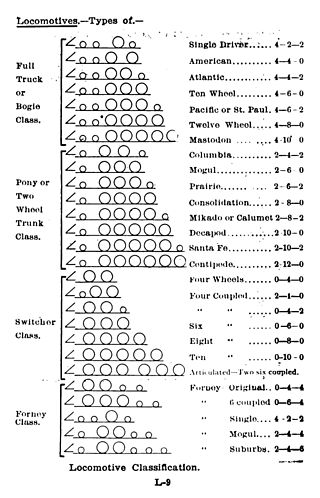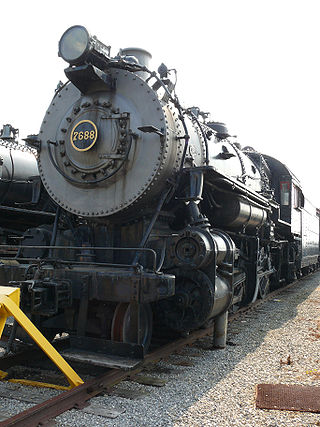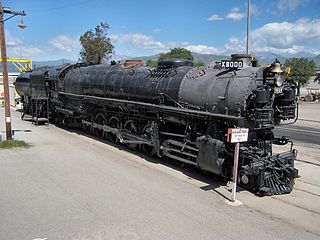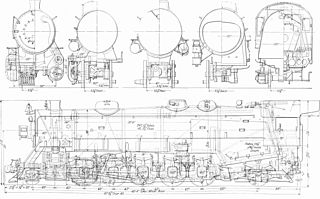
The Whyte notation is a classification method for steam locomotives, and some internal combustion locomotives and electric locomotives, by wheel arrangement. It was devised by Frederick Methvan Whyte, and came into use in the early twentieth century following a December 1900 editorial in American Engineer and Railroad Journal.
Under the Whyte notation for the classification of steam locomotives, 2-10-0 represents the wheel arrangement of two leading wheels on one axle, ten powered and coupled driving wheels on five axles, and no trailing wheels. This arrangement was often named Decapod, especially in the United States, although this name was sometimes applied to locomotives of 0-10-0 "Ten-Coupled" arrangement, particularly in the United Kingdom. Notable German locomotives of this type include the war locomotives of Class 52.

The Pennsylvania Railroad's class H8, H9s and H10s steam locomotives were of the 2-8-0 "Consolidation" type, the last three classes of such built by the railroad. The three classes differed only in cylinder diameter and thus tractive effort, each subsequent class increasing that measurement by an inch. The first H8 was built in 1907 and the last H10 in 1916; within a few years they were replaced on heavy freight assignments by 2-8-2s and 2-10-0. They became the railroad's standard light freight locomotive, replacing all other class H 2-8-0s, and a number remained in service until the end of PRR steam locomotive operation in 1957. 968 class H8 of various subclasses were constructed, along with 274 class H9s and 273 class H10s. A number of H8 locomotives were rebuilt to H9s specification.
Under the Whyte notation for the classification of steam locomotives, 0-8-0 represents the wheel arrangement of no leading wheels, eight powered and coupled driving wheels on four axles and no trailing wheels. Locomotives of this type are also referred to as eight coupled.
Under the Whyte notation for the classification of steam locomotives by wheel arrangement, a 2-6-6-2 is a locomotive with one pair of unpowered leading wheels, followed by two sets of three pairs of powered driving wheels and one pair of trailing wheels. The wheel arrangement was principally used on Mallet-type articulated locomotives, although some tank locomotive examples were also built. A Garratt locomotive or Golwé locomotive with the same wheel arrangement is designated 2-6-0+0-6-2 since both engine units are pivoting.

The Union Pacific Railroad 9000 Class was a class of 88 steam locomotives, built by ALCO for the Union Pacific between 1926 and 1930.

The USRA 0-6-0 was a USRA standard class of steam locomotive designed under the control of the United States Railroad Administration, the nationalized railroad system in the United States during World War I. This was the standard light switcher locomotive of the USRA types, and was of 0-6-0 wheel arrangement in the Whyte notation, or "C" in UIC classification.

The USRA Light Mikado was a USRA standard class of steam locomotive designed under the control of the United States Railroad Administration, the nationalized railroad system in the United States during World War I. This was the standard light freight locomotive of the USRA types, and was of 2-8-2 wheel arrangement in the Whyte notation, or 1′D1′ in UIC classification.

The USRA Heavy Mikado was a USRA standard class of steam locomotive designed under the control of the United States Railroad Administration (USRA), the nationalized railroad system in the United States during World War I. These locomotives were of 2-8-2 wheel arrangement in the Whyte notation, or 1′D1′ in UIC classification. A total of 233 locomotives were built to this plan for the USRA; postwar, it became a de facto standard design, which was built to the total of 957 locomotives including the USRA originals and all subsequent copies.

The USRA Heavy Santa Fe was a USRA standard class of steam locomotive designed under the control of the United States Railroad Administration, the nationalized railroad system in the United States during World War I. These locomotives were of 2-10-2 wheel arrangement in the Whyte notation, or 1′E1′ in UIC classification; this arrangement was commonly named "Santa Fe" in the United States. At the time, the Santa Fe was the largest non-articulated type in common use, primarily in slow drag freight duty in ore or coal service.

The USRA Light Santa Fe was a USRA standard class of steam locomotive designed under the control of the United States Railroad Administration, the nationalized railroad system in the United States during World War I. These locomotives were of 2-10-2 wheel arrangement in the Whyte notation, or 1′E1′ in UIC classification; this arrangement was commonly named "Santa Fe" in the United States. At the time, the Santa Fe was the largest non-articulated type in common use, primarily in slow drag freight duty in ore or coal service.

The Pennsylvania Railroad's class N2sa comprised rebuilds to PRR practice of the 130 USRA Heavy Santa Fe steam locomotives the railroad received under the auspices of the United States Railroad Administration, the nationalized central control of the nation's railroads during World War I. These locomotives, as received, were classified N2s. Rebuilds began from 1923 and all locomotives were rebuilt, classified N2sa after the rebuild. They received a Belpaire firebox, the PRR-standard smokebox front, a raised headlight following PRR practice, and the bell moved from smokebox front to boiler top. Brakemen's "doghouse" shacks were built on the rear tender decks.

The Wabash Railroad's class P-1 comprised seven 4-6-4 steam locomotives rebuilt from 5 Class K-5 2-8-2's numbered 2600-2604 and 2 Class K-4 2-8-2's numbered 2743 and 2744.

Pennsylvania Railroad Class L1s were 2-8-2 "Mikado"-type steam locomotives that were used on the Pennsylvania Railroad during the early twentieth century. These 574 locomotives were manufactured between 1914 and 1919 by the railroad's own Juniata Shops as well as the Baldwin Locomotive Works (205) and the Lima Locomotive Works (25).

The USRA Light Pacific was a USRA standard class of steam locomotive designed under the control of the United States Railroad Administration, the nationalized railroad system in the United States during World War I. It was the standard light passenger locomotive of the USRA types, with a 4-6-2 wheel arrangement in the Whyte notation, or 2′C1′ in UIC classification.
The USRA 2-8-8-2 was a USRA standard class of steam locomotive designed under the control of the United States Railroad Administration, the nationalized railroad system in the United States during World War I. These locomotives were of 2-8-8-2 wheel arrangement in the Whyte notation, or (1'D)'D1' in UIC classification. A total of 106 locomotives were built to this plan for the USRA; postwar, it became a de facto standard design.
The USRA Heavy Pacific was a USRA standard class of steam locomotive designed under the control of the United States Railroad Administration, the nationalized railroad system in the United States during World War I. This was the standard heavy passenger locomotive of the USRA types, and was 4-6-2 wheel arrangement in the Whyte notation, or 2′C1′ in UIC classification.
The USRA Light Mountain was a USRA standard class of steam locomotive designed under the control of the United States Railroad Administration, the nationalized railroad system in the United States during World War I. This was the standard light freight locomotive of the USRA types, and was of 4-8-2 wheel arrangement in the Whyte notation, or 2′D1′ in UIC classification.
The USRA Heavy Mountain was a USRA standard class of steam locomotive designed under the control of the United States Railroad Administration, the nationalized railroad system in the United States during World War I. This was the standard light freight locomotive of the USRA types, and was of 4-8-2 wheel arrangement in the Whyte notation, or 2′D1′ in UIC classification.
The Norfolk and Western Class Y3a was a class of 2-8-8-2 mallet articulated steam locomotive with a total of 30 locomotives built for the Norfolk and Western Railway in 1923.












